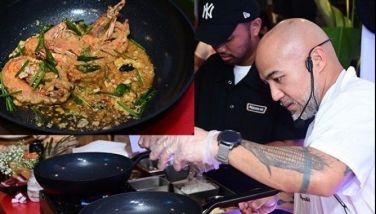To taste the world
He was a simple pot washer at 14 in a small restaurant in Hallstahammar, a town in Sweden. Now at 40, he has probably met a citizen of each nation, has seen every continent and has perhaps circumnavigated the world far too many times. Chef Mats Loo, director of First Gourmet Academy frankly says, “The reason I wanted to be a chef was because it was easy to travel. If you’re a doctor, you’re required to speak the language, but if you’re a chef, it’s not necessary. You can pick up the language of the country while working in the kitchen. I worked in Switzerland and I didn’t speak French. You talk a lot with your hands. It was the same when I worked in Spain. My Spanish was bad. But it’s the same type of people in all these profession kitchens.”
Though the kitchen has been his door to the world, his passion for life is expressed in one place alone — the kitchen. Mats has unselfishly sacrificed for the sake of culinary experience, rising higher and higher in the most prestigious restaurant kitchens in Europe. In 1994, he worked in the famed L’Ortolan in Reading, England alongside Michelin-star chef John Burton Race, after which he was also a chef in one of London’s high-class hotels, in Michelin-star restaurant The Capital. After setting foot in a few more top restaurants, he finally realized that taking charge of cruise ship kitchens was most satisfying. He was executive chef for three major cruise ships. For a year he stayed onboard Silver Sea, an Italian liner that had 280 passengers. He then stayed on European cruise ship Silja Line for two and a half years serving 3,000 passengers. Chef Mats Loo’s final stint was with legendary luxury cruise ship, MS Caledonian Star where he stayed for 12 years serving 180 passengers.
He bares the truth behind the lifestyle of a chef. “I spent three years in London, and that was even harder than cruise ships. I worked for three different restaurants. London is a tough place to work in, as a chef, and you don’t really make that much money but you gain a lot of experience. I couldn’t pay the rent sometimes. I slept on the streets for a few nights.” There were a few occasions where he would save for a week’s rent and to stay in a colleague’s place. Mats continues, “And you put your bags in a train station where they have those big lockers and you slept somewhere on the streets or you slept in the locker room of the restaurant where you work. I spent eight weeks sleeping on the sofa of the restaurant I worked in. You become a much better chef and a much better person. That’s what you learn. You work 16 hours a day then you catch the night bus home. When you miss the night bus, you wait for the next one around an hour and a half later on. You come home at 3 o’clock in the morning then sleep two or three hours ‘cause you have to leave the following morning in order to be back at 8 o’ clock. That’s what a lot of chefs do. And I miss it.”
Though this chef may have taken only eight months of formal training in Virginska Skolan, Orebro in his native Sweden, his vast experience accounts much for his prowess that has been tried and tested, especially in big cruise ships where he supervised more than 70 crewmembers. Mats recalls his routine on the cruise ship. “It’s difficult when you’re having dinner for a number of people and when you’re on a crew ship, it could be hundreds. When your supply doesn’t come on time, you have to come up with something. Let’s say you’re trying to prepare a certain type of fish, and when you’re supposed to cook it, it’s not there. You have to get something else and you only have a certain amount of time to do that. That could be very stressful especially if it’s for 200 people. You find that 20 minutes before (food is to be served) and you have to run down to the freezer and defrost (a substitute food) quickly. You have to tell all the guests in the dining that the menu will be changed. But it’s a challenge.” Nearly each meal prepared was a challenge. “Especially in the small cruise ship, we had 110 passengers and it was often that things just didn’t show up. We go to port at 2 in the afternoon and at 4 p.m. we have to leave. If by 4 the produce is not there, you still have to leave,” says the chef as he remembers another memorable experience.
“I also did this nightmare cruise, a 36-day cruise which was in South America all the way to Portugal and in the middle of this is the Atlantic ridge where you have 22 days at sea and you don’t get anything at all. For the last two days you’re basically mopping up the floor and fridge finding what you can cook with. That was a challenge also but it was fun.”
So what is this Swede doing in the Philippines? In 1999, a stewardess on the MS Caledonian Star smote chef Mats Loo. It was no other than a Filipina named Reggie Tiomico whom he now has two children with. Deciding to stay on dry land since 2007, he has taught in other local culinary schools before partnering with Dennis Nakpil and Romy Mercado to put up First Gourmet Academy.
As director of First Gourmet Academy, Mats runs the academic and administrative fronts. Currently all of Mats’ efforts are poured into the Academy, located on Capitol Hills Drive in Old Balara, Quezon City. Their spacious kitchen with state-of-the-art equipment and facilities boasts of a spectacular view of a golf course and that of Marikina and Antipolo.
The Academy offers two diploma courses. The Commercial Cooking and Culinary Arts is a diploma course for those who want to be a master chef pronto. It is taken in six months with a three-month internship in an establishment in the Philippines, or abroad in a hotel, restaurant or resort. Among the culinary topics discussed are food safety and sanitation, basic culinary skills and food science, baking and pastry, garde manger and international cuisines.
The Commercial Cooking, Culinary Arts and Entrepreneurship diploma course, on the other hand, is for the aspiring chef who dreams of opening a restaurant, bar or catering business. The duration is eight months followed by a three-month internship in an establishment here in the Philippines, or abroad in a hotel, restaurant or resort. The curriculum covers basic restaurant design, wine appreciation, bartending, service styles and kitchen management.
First Gourmet Academy also offers short certified courses (eight sessions) ideally designed for hobbyists, homemakers and foodie professionals who would like to whip up wonderful cuisines for social gatherings or for loved ones.
Mats observes, “If you’re a chef here in the Philippines, it seems like you have to work with only imported ingredients but I don’t know if I agree with that. The fish and the shellfish here are probably the best in the world.” He comments on contemporary Filipino cooking, “Food in the Philippines is often confusing. They try to put a lot of different things. Often it falls flat and it doesn’t really work. There are too many flavors and there are too many textures in one plate. You can have one or two great flavors and one texture and that should be enough.”
Chef Mats Loo intends to return to Sweden in the far future. For now, he teaches his students at the Academy not only the tastes of the world but the ways of the world.
(For those interested, First Gourmet Academy may be reached at 951-1687.)
- Latest





























